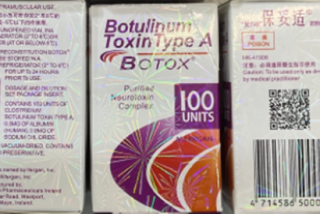Smoothing wrinkles safely?
Botox is known for smoothing furrowed brows. Now it’s causing a few.
The Food and Drug Administration last month issued a statement that Botox and another botulinum toxin drug, Myobloc, have been linked to serious respiratory and swallowing problems and at least one death.
And consumers seeking to smooth their facial lines want to know: Is it safe?
The primary fact to keep in mind, doctors say, is that Botox -- the only botulinum toxin drug approved in the U.S. for cosmetic purposes -- has a stellar safety record.
Since 2002, when the drug was approved for temporary treatment of so-called glabellar lines -- the lines between the brows -- more than 13 million doses have been administered for that purpose, including more than 3 million doses in 2006. The most common side effects are bruising and pain at the site of the injection.
Although the FDA did not list in detail the number and nature of the cases that it’s reviewing, the agency later reported that it was looking at fewer than 100 incidents of serious adverse reactions. Most of these reactions followed treatment for medical conditions, such as juvenile cerebral palsy, in which Botox is used to relax tense, rigid muscles. In these treatments, the quantities used are much higher than those administered for cosmetic purposes.
There have been a few reports of serious side effects with cosmetic use, “but it’s extremely rare,” said Russell Katz, director of the FDA’s division of neurology drugs in a Feb. 8 conference call with news media. “And it’s not even really clear whether or not those events could be attributed to the treatment.”
Further, Katz reported that the FDA is not aware of any deaths directly caused by cosmetic use of Botox, although it is continuing to investigate.
Dermatologists have rallied to the support of Botox.
“The consensus is that there have been no shown issues related to the aesthetic uses of Botox,” says Dr. Neil Sadick, clinical professor of dermatology at Weill Medical College of Cornell University in New York. Sadick canvassed his colleagues after the FDA released its statement.
But not so fast, says the consumer advocacy group Public Citizen.
In its own analysis of the FDA’s database, Public Citizen in January reported 180 serious adverse reactions and 16 deaths linked to the drug between 1997 and 2006, with one death linked to cosmetic use.
The group is petitioning the FDA to require drug makers to provide more specific information to physicians and patients about the drug’s possible side effects, which include paralysis of the respiratory muscles and esophagus, which can lead to aspiration pneumonia and death.
Botox’s chief constituent, botulinum toxin, is nothing to be trifled with. It is made from the deadly Clostridium botulinum, the bacterium that causes food poisoning. Naturally occurring in soil and improperly canned food, it is the most toxic protein in the world, pound for pound. In small amounts, it is extremely effective in blocking the transmission of overactive nerve impulses, resulting in a relaxing of the muscles.
Botox has been approved by the FDA for treatment of conditions such as crossed eyes; spasm of the eyelids; cervical dystonia, which is characterized by severe neck muscle spasms; and severe underarm sweating. Botox Cosmetic, which is the same product under a different name, has been approved by the FDA for treatment of frown lines. (Myobloc, also known as botulinum toxin Type B, is only approved by the FDA for the treatment of adults with cervical dystonia. Myobloc and Botox are made from different strains of the bacterium.)
In addition to its FDA-approved uses, Botox has been found effective, to varying degrees, in non-FDA approved treatment of a number of other conditions, including stroke, multiple sclerosis, Parkinson’s disease, excessive salivation, excessively sweaty palms and spasms of the vocal cords.
It also has been found to be very effective in the off-label treatment of cerebral palsy, says Dr. William Oppenheim, director of UCLA’s Center for Cerebral Palsy and professor of orthopedic surgery. “For our patients, the alternative to Botox is often surgery to lengthen muscles, which has its risks, or Valium and other antispasticity medicines, which are effective but not as effective as the Botox appears to be.”
Oppenheim has not encountered the problems with the drug reported by the FDA and says it has been safely administered to tens of thousands of cerebral palsy patients in the U.S. “People need to know there are risks associated with any treatment, but we think Botox is one of the least risky drugs.”
Not only do the medical applications require large doses of Botox, for some conditions, but the injections are made near the throat, which is where problems can occur.
When large quantities of the drug are used, it can travel beyond the injection site to the respiratory muscles. Similarly, when the drug is injected in the lower portion of the face or the neck, there is a risk of it affecting the esophagus.
Public Citizen thinks the FDA should do more to inform the public of the risks of botulinum toxin drugs, regardless of how they are used. “There have been reports of eyelid difficulties with the approved cosmetic use” of Botox, says Dr. Sidney Wolfe, director of Public Citizen’s Health Research Group. Further, he says, safety data from clinical trials only exists for cosmetic use in the forehead, not the common practice of using it lower on the face.
Part of the problem, he says, is that once a drug is approved by the FDA, physicians can use it for any purpose.
The FDA is evaluating data from the drug manufacturers and has asked them to submit their own comprehensive reviews of their databases. “We’re in the middle of trying to get a better handle on the details,” Katz says.
Meanwhile, dermatologists swear by its safety.
“In the aesthetic arena,” Sadick says, “it still remains the gold standard of safety.”
--




